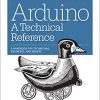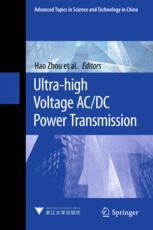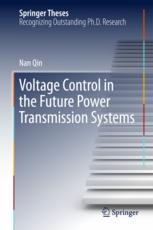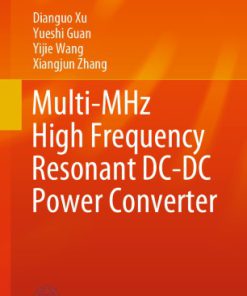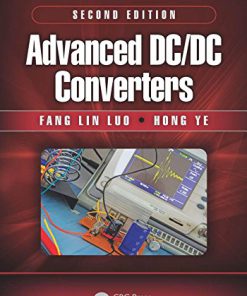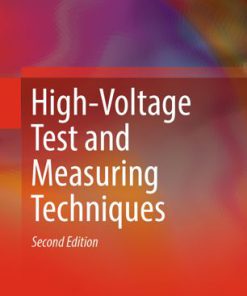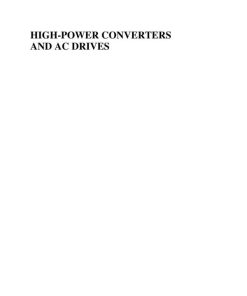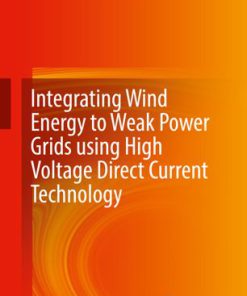High voltage direct current transmission converters systems and DC grids 2nd Edition by Dragan Jovcic ISBN 1119566614 9781119566618
$50.00 Original price was: $50.00.$25.00Current price is: $25.00.
High voltage direct current transmission : converters, systems and DC grids 2nd Edition by Dragan Jovcic – Ebook PDF Instant Download/Delivery: 1119566614, 978-1119566618
Full dowload High voltage direct current transmission : converters, systems and DC grids 2nd Edition after payment
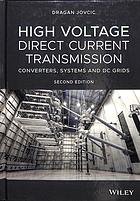
Product details:
ISBN 10: 1119566614
ISBN 13: 978-1119566618
Author: Dragan Jovcic
Presents the latest developments in switchgear and DC/DC converters for DC grids, and includes substantially expanded material on MMC HVDC
This newly updated edition covers all HVDC transmission technologies including Line Commutated Converter (LCC) HVDC; Voltage Source Converter (VSC) HVDC, and the latest VSC HVDC based on Modular Multilevel Converters (MMC), as well as the principles of building DC transmission grids.
Featuring new material throughout, High Voltage Direct Current Transmission: Converters, Systems and DC Grids, 2nd Edition offers several new chapters/sections including one on the newest MMC converters. It also provides extended coverage of switchgear, DC grid protection and DC/DC converters following the latest developments on the market and in research projects. All three HVDC technologies are studied in a wide range of topics, including: the basic converter operating principles; calculation of losses; system modelling, including dynamic modelling; system control; HVDC protection, including AC and DC fault studies; and integration with AC systems and fundamental frequency analysis. The text includes:
- A chapter dedicated to hybrid and mechanical DC circuit breakers
- Half bridge and full bridge MMC: modelling, control, start-up and fault management
- A chapter dedicated to unbalanced operation and control of MMC HVDC
- The advancement of protection methods for DC grids
- Wideband and high-order modeling of DC cables
- Novel treatment of topics not found in similar books, including SimPowerSystems models and examples for all HVDC topologies hosted by the 1st edition companion site.
High Voltage Direct Current Transmission: Converters, Systems and DC Grids, 2nd Edition serves as an ideal textbook for a graduate-level course or a professional development course.
High voltage direct current transmission : converters, systems and DC grids 2nd Table of contents:
Part I: HVDC with Current Source Converters
-
Introduction to Line Commutated HVDC
- 1.1 HVDC Applications
- 1.2 Line Commutated HVDC Components
- 1.3 DC Cables and Overhead Lines
- 1.4 LCC HVDC Topologies
- 1.5 Losses in LCC HVDC Systems
- 1.6 Conversion of AC Lines to DC
- 1.7 Ultra High Voltage HVDC
-
Thyristors
- 2.1 Operating Characteristics
- 2.2 Switching Characteristics
- 2.3 Losses in HVDC Thyristors
- 2.4 Valve Structure and Thyristor Snubbers
- 2.5 Thyristor Rating Selection and Overload Capability
-
Six-pulse Diode and Thyristor Converter
- 3.1 Three-phase Uncontrolled Bridge
- 3.2 Three-phase Thyristor Rectifier
- 3.3 Analysis of Commutation Overlap in a Thyristor Converter
- 3.4 Active and Reactive Power in a Three-phase Thyristor Converter
- 3.5 Inverter Operation
-
HVDC Rectifier Station Modelling, Control and Synchronisation with AC System
- 4.1 HVDC Rectifier Controller
- 4.2 Phase-locked Loop
- 4.3 Master-level HVDC Control
-
HVDC Inverter Station Modelling and Control
- 5.1 Inverter Controller
- 5.2 Commutation Failure
-
HVDC System V–I Diagrams and Operating Modes
- 6.1 HVDC Equivalent Circuit
- 6.2 HVDC V–I Operating Diagram
- 6.3 HVDC Power Reversal
-
HVDC Analytical Modelling and Stability
- 7.1 Introduction to Converter and HVDC Modelling
- 7.2 HVDC Analytical Model
- 7.3 CIGRE HVDC Benchmark Model
- 7.4 Converter Modelling, Linearisation, and Gain Scheduling
- 7.5 AC System Modelling for HVDC Stability Studies
- 7.6 LCC Converter Transformer Model
- 7.7 DC System Including DC Cable
- 7.8 Accurate DC Cable Modelling
- 7.9 HVDC–HVAC System Model
- 7.10 Analytical Dynamic Model Verification
- 7.11 Basic HVDC Dynamic Analysis
- 7.12 HVDC Second Harmonic Instability
- 7.13 100 Hz Oscillations on the DC Side
-
HVDC Phasor Modelling and Interactions with AC System
- 8.1 Converter and DC System Phasor Model
- 8.2 Phasor AC System Model and Interaction with DC System
- 8.3 Inverter AC Voltage and Power Profile as DC Current is Increasing
- 8.4 Influence of Converter Extinction Angle
- 8.5 Influence of Shunt Reactive Power Compensation
- 8.6 Influence of Load at the Converter Terminals
- 8.7 Influence of Operating Mode (DC Voltage Control Mode)
- 8.8 Rectifier Operating Mode
-
HVDC Operation with Weak AC Systems
- 9.1 Introduction
- 9.2 Short Circuit Ratio and Equivalent Short Circuit Ratio
- 9.3 Background on Power Transfer Between Two AC Systems
- 9.4 Phasor Study of Converter Interactions with Weak AC Systems
- 9.5 System Dynamics (Small Signal Stability) with Low SCR
- 9.6 Control and Main Circuit Solutions for Weak AC Grids
- 9.7 LCC HVDC with SVC
- 9.8 Capacitor Commutated Converters for HVDC
- 9.9 AC System with Low Inertia
-
Fault Management and HVDC System Protection
- 10.1 Introduction
- 10.2 DC Line Faults
- 10.3 AC System Faults
- 10.4 Internal Faults
- 10.5 System Reconfiguration for Permanent Faults
- 10.6 Overvoltage Protection
- LCC HVDC System Harmonics
- 11.1 Harmonic Performance Criteria
- 11.2 Harmonic Limits
- 11.3 Thyristor Converter Harmonics
- 11.4 Harmonic Filters
- 11.5 Non-characteristic Harmonic Reduction Using HVDC Controls
Part II: HVDC with Voltage Source Converters
- VSC HVDC Applications and Topologies, Performance and Cost Comparison with LCC HVDC
- 12.1 Application of Voltage Source Converters in HVDC
- 12.2 Comparison with LCC HVDC
- 12.3 HVDC Technology Landscape
- 12.4 Overhead and Subsea/Underground VSC HVDC Transmission
- 12.5 DC Cable Types with VSC HVDC
- 12.6 Monopolar and Bipolar VSC HVDC Systems
- 12.7 VSC HVDC Converter Topologies
- 12.8 VSC HVDC Station Components
- 12.9 AC Inductors
- 12.10 DC Inductors
- IGBT Switches and VSC Converter Losses
- 13.1 Introduction to IGBT and IGCT
- 13.2 General VSC Converter Switch Requirements
- 13.3 IGBT Technology
- 13.4 High Power IGBT Devices
- 13.5 IEGT Technology
- 13.6 Losses Calculation
- 13.7 Balancing Challenges in Two-level IGBT Valves
- 13.8 Snubber Circuits
- Single-phase and Three-phase Two-level VSC Converters
- 14.1 Introduction
- 14.2 Single-phase VSC
- 14.3 Three-phase VSC
- 14.4 Square-wave, Six-pulse Operation
- Two-level PWM VSC Converters
- 15.1 Introduction
- 15.2 PWM Modulation
- 15.3 Sinusoidal Pulse Width Modulation
- 15.4 Third Harmonic Injection
- 15.5 Selective Harmonic Elimination Modulation
- 15.6 Converter Losses for Two-level SPWM VSC
- 15.7 Harmonics with PWM
- 15.8 Comparison of PWM Modulation Techniques
- Multilevel VSC Converters in HVDC Applications
- 16.1 Introduction
- 16.2 Modulation Techniques for Multilevel Converters
- 16.3 Neutral Point Clamped Multilevel Converter
- 16.4 Half Bridge MMC
- 16.5 Full Bridge MMC
- 16.6 Comparison of Multilevel Topologies
- Two-level VSC HVDC Modelling, Control, and Dynamics
- 17.1 PWM Two-level Converter Average Model
- 17.2 Two-level PWM Converter Model in DQ Frame
- 17.3 VSC Converter Transformer Model
- 17.4 Two-level VSC Converter and AC Grid Model in the ABC Frame
- 17.5 Two-level VSC Converter and AC Grid Model in a DQ Rotating Coordinate Frame
- 17.6 VSC Converter Control Principles
- 17.7 The Inner Current Controller Design
- 17.8 Outer Controller Design
- 17.9 Complete Two-level VSC Converter Controller
- 17.10 Small Signal Linearised VSC HVDC Model
- 17.11 Small Signal Dynamic Studies
- Two-level VSC HVDC Phasor-domain Interaction with AC Systems and PQ Operating Diagrams
- 18.1 Power Exchange Between Two AC Voltage Sources
- 18.2 Converter Phasor Model and Power Exchange with an AC System
- 18.3 Phasor Study of VSC Converter Interaction with AC System
- 18.4 Operating Limits
- 18.5 Design Point Selection
- 18.6 Influence of AC System Strength
- 18.7 Influence of AC System Impedance Angle (Xs/Rs)
- 18.8 Influence of Transformer Reactance
- 18.9 Influence of Converter Control Modes
- 18.10 Operation with Very Weak AC Systems
- Half Bridge MMC: Dimensioning, Modelling, Control, and Interaction with AC System
- 19.1 Basic Equations and Steady-state Control
- 19.2 Steady-state Dimensioning
- 19.3 Half Bridge MMC Non-linear Average Dynamic Model
- 19.4 Non-linear Average Value Model Including Blocked State
- 19.5 HB MMC HVDC Start-up and Charging MMC Cells
- 19.6 HB MMC Dynamic DQ Frame Model and Phasor Model
- 19.7 Second Harmonic of Differential Current
- 19.8 Complete MMC Converter DQ Model in Matrix Form
- 19.9 Second-harmonic Circulating Current Suppression Controller
- 19.10 Simplified DQ Frame Model with Circulating Current Controller
- 19.11 Phasor Model of MMC with Circulating Current Suppression Controller
- 19.12 Simplified Dynamic MMC Model Using Equivalent Series Capacitor CM MC
- 19.13 Full Dynamic Analytical HB MMC Model
- 19.14 HB MMC Controller and Arm Voltage Control
- 19.15 MMC Total Series Reactance and Comparison with Two-level VSC
- 19.16 MMC Interaction with AC System and PQ Operating Diagrams
- Full Bridge MMC Converter: Dimensioning, Modelling, and Control
- 20.1 FB MMC Arm Voltage Range
- 20.2 Full Bridge MMC Converter Non-linear Average Model
- 20.3 FB MMC Non-linear Average Model Including Blocked State
- 20.4 Full Bridge MMC Cell Charging
- 20.5 Hybrid MMC Design
- 20.6 Full Bridge MMC DC Voltage Variation Using a Detailed Model
- 20.7 FB MMC Analytical Dynamic DQ Model
- 20.8 Simplified FB MMC Model
- 20.9 FB MMC Converter Controller
- MMC Converter Under Unbalanced Conditions
- 21.1 Introduction
- 21.2 MMC Balancing Controller Structure
- 21.3 Balancing Between Phases (Horizontal Balancing)
- 21.4 Balancing Between Arms (Vertical Balancing)
- 21.5 Simulation of Balancing Controls
- 21.6 Operation with Unbalanced AC Grid
- VSC HVDC Under AC and DC Fault Conditions
- 22.1 Introduction
- 22.2 Faults on the AC System
- 22.3 DC Faults with Two-level VSC
- 22.4 Influence of DC Capacitors
- 22.5 VSC Converter Modelling Under DC Faults and VSC Diode Bridge
- 22.6 VSC Converter Mode Transitions as DC Voltage Reduces
- 22.7 DC Faults with Half Bridge Modular Multilevel Converter
- 22.8 Full Bridge MMC Under DC Faults
- VSC HVDC Application For AC Grid Support and Operation with Passive AC Systems
- 23.1 VSC HVDC High Level Controls and AC Grid Support
- 23.2 HVDC Embedded Inside an AC Grid
- 23.3 HVDC Connecting Two Separate AC Grids
- 23.4 HVDC in Parallel with AC
- 23.5 Operation with a Passive AC System and Black Start Capability
- 23.6 VSC HVDC Operation with Offshore Wind Farms
- 23.7 VSC HVDC Supplying Power Offshore and Driving a MW-Size Variable Speed Motor
Part III: DC Transmission Grids
- Introduction to DC Grids
- 24.1 DC versus AC Transmission
- 24.2 Terminology
- 24.3 DC Grid Planning, Topology, and Power Transfer Security
- 24.4 Technical Challenges
- 24.5 DC Grid Building by Multiple Manufacturers – Interoperability
- 24.6 Economic Aspects
- DC Grids With Line Commutated Converters
- 25.1 Multiterminal LCC HVDC
- 25.2 Italy–Corsica–Sardinia Multiterminal HVDC Link
- 25.3 Connecting the LCC Converter to a DC Grid
- 25.4 Control of LCC Converters in DC Grids
- 25.5 Control of LCC DC Grids Through DC Voltage Droop Feedback
- 25.6 Managing LCC DC Grid Faults
- 25.7 Reactive Power Issues
- 25.8 Employing LCC Converter Stations in Established DC Grids
- DC Grids with Voltage Source Converters and Power Flow Model
- 26.1 Connecting a VSC Converter to a DC Grid
- 26.2 Multiterminal VSC HVDC Operating in China
- 26.3 DC Grid Power Flow Model
- 26.4 DC Grid Power Flow Under DC Faults
- DC Grid Control
- 27.1 Introduction
- 27.2 Fast Local VSC Converter Control in DC Grids
- 27.3 DC Grid Dispatcher with Remote Communication
- 27.4 Primary, Secondary, and Tertiary DC Grid Control
- 27.5 DC Voltage Droop Control for VSC Converters in DC Grids
- 27.6 Three-level Control for VSC Converters with Dispatcher Droop
- 27.7 Power Flow Algorithm When DC Powers are Regulated
- 27.8 Power Flow and Control Study of CIGRE DC Grid Test System
- DC Circuit Breakers
- 28.1 Introduction
- 28.2 Challenges with DC Circuit Opening
- 28.3 DC CB Operating Principles and a Simple Model
- 28.4 DC CB Performance Requirements
- 28.5 Practical HV DC CBs
- 28.6 Mechanical DC CB
- 28.7 Semiconductor-based DC CB
- 28.8 Hybrid DC CB
- DC Grid Fault Management and Protection System
- 29.1 Introduction
- 29.2 Fault Current Components in DC Grids
- 29.3 DC System Protection Coordination with AC System Protection
- 29.4 DC Grid Protection System Development
- 29.5 DC Grid Protection System Based on Local Measurements
- 29.6 Blocking MMC Converters Under DC Faults
- 29.7 Differential DC Grid Protection Strategy
- 29.8 Selective Protection for Star-topology DC Grids
- 29.9 DC Grids with DC Fault-tolerant VSC Converters
- 29.10 DC Grids with Full Bridge MMC Converters
- High Power DC/DC Converters and DC Power Flow Controlling Devices
- 30.1 Introduction
- 30.2 Power Flow Control Using Series Resistors
- 30.3 Low-stepping-ratio DC/DC Converters (DC Choppers)
- 30.4 Non-isolated MMC-based DC/DC Converter (M2DC)
- 30.5 DC/DC Converters with DC Polarity Reversal
- 30.6 High-stepping-ratio Isolated DC/DC Converter (Dual Active Bridge DC/DC)
- 30.7 High-stepping-ratio LCL DC/DC Converter
- 30.8 Building DC Grids with DC/DC Converters
- 30.9 DC Hubs
- 30.10 Developing DC Grids Using DC Hubs
- 30.11 North Sea DC Grid Topologies
People also search for High voltage direct current transmission : converters, systems and DC grids 2nd:
extruded cables for high voltage direct current transmission
siemens high voltage direct current transmission
analysing the costs of high voltage direct current (hvdc) transmission
what is high voltage direct current
why high voltage dc power transmission
You may also like…
Engineering - Energy & Power Resources
Ultra high Voltage AC DC Power Transmission 1st Edition Hao 3662545756 9783662545751
Romance - Romantic Comedy
High Voltage An Enemies To Lovers Romance 1st Edition by Hudson ISBN 8717353595 9788717353595
Engineering
Cookbooks



